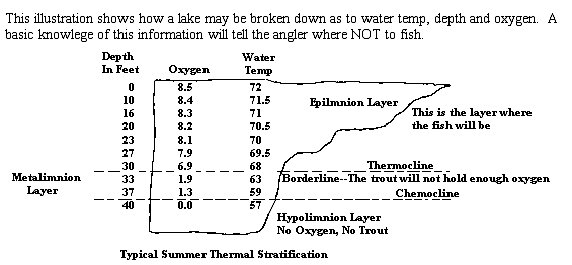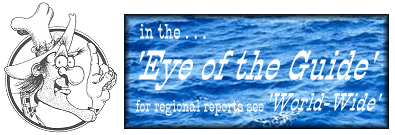UNDERSTANDING THE STILLWATER AND THE TROUT
In his 1978 book Fly Fishing Still Waters, Don Roberts does an excellent job of describing the challenges of stillwater fly fishing. I would like to share with you a passage from page 6 of that volume.
"Rivers are so obvious in their beauty that they inspire infatuation. Lakes require study, commitment. Rivers flow only one way. Lakes have infinite patterns, moods, guises. Rivers are brash and constant in their conversation. Lakes are quiet, haunting, lyrical."
Once you have studied the food organisms, mapped and charted the stillwater you wish to fish and selected your tackle, there are still a few more items that the angler must understand before fishing. The largest obstacle to catching trout is locating them and understanding why they are where they are.
Zoning your Lake
Littoral Zone: This area consists of several bands of rooted aquatic vegetation extending from the shoreline lake ward, to the limit of the rooted aquatic vegetation. (There are some lakes with very large and expansive littoral zones.) This zone has the highest concentration of aquatic food life and generally holds the most trout. The water depth in the littoral zone is generally from 6 inches to 10 feet. But in some shallow lakes the littoral zone can extend into 25 feet of water.
Sublittoral Zone: Generally this occurs where you start to lose the rooted aquatic vegetation and there is a drop off. The water depth will vary.
Limnetic Zone: Covers the open, deep water in the center of the lake and is surrounded by the littoral and sublittoral zones. Vertically this zone extends from the surface of the lake to almost the bottom where it overlays the profundal zone. This zone is further broken down into two levels.
The upper level contains floating weed beds, some aquatic life, vast amounts of microscopic zooplankton and single cell algae called phytoplankton. During certain times of the year trout can be found feeding in this zone on floating snails, flying ants and cruising the edges of the floating weed beds.
Profundal Zone: This is that portion of the lake bottom under the limnetic zone. Generally little or no light reaches this region. The water is high in carbon dioxide and low in oxygen. The bottom will contain vast amounts of organic materials. Bacteria, fingernail clams and some insect larvae that are tolerant to low oxygen conditions can be found. Trout, however, will not be found in the lower limnetic zone or in the profundal zone.
There are certain factors which determine what aquatic food forms will be found in a stillwater. They are: depth of the stillwater, oxygen content of the water, alkalinity, and aquatic vegetation.
Most lakes can be charted out as to water depth, oxygen content, and water temp. Once a stillwater falls below certain levels, you may have fish kill, or find the trout very sluggish and easily killed while playing and landing. Often, during prolonged high temps, you may find the trout very susceptible to fungus.
Many of the aquatic food forms on which the trout feed inhabit a wide variety of aquatic vegetation. They live on this vegetation and feed. The more aquatic vegetation a stillwater has, the more aquatic food forms it will have and thus be more biologically productive in terms of trout size and numbers. Aquatic vegetation can be broken down into 3 major groups, these being emergent, floating and submerged.
The following is a list of the basic forms of aquatic plants found in stillwaters and their significance to the angler.
1. Nuphar
2. Vallisneria
3. Lily Pads
4. Anacharis
5. P. Crispus
6. Myriophyllum
7. Potamogeton

Often one will find the aquatic vegetation laid out in parallel zones starting from the shoreline and extending out into the lake. Those are the areas where the trout are most often found cruising and feeding on the available aquatic food forms.
To break it down even further, the angler must learn to determine which weed type harbors the greater quantities of aquatic food forms sought by the trout during the various seasons and times of day. This can be learned by observation and collection.
The Aquatic Weed Zones
First Zone: Holds those plants which are rooted to the lake bottom but whose tops extend in the air. These may be cattails, bulrushes, reeds, wild rice and others. This zone may extend into 6 feet of water.
Second Zone: This zone lies in deeper water of 6 to 15 feet, and is composed of vegetation that is rooted in the bottom but has an exposed floating portion. These plants can also be found in very shallow water. Remember, nothing is hard and fast and not all stillwaters have all types of vegetation or zones.
Third Zone: Can be found in deeper water of 4 to 20 feet and consists of submerged vegetation like Anacharis (pondweed), eelgrass, and others.
The more you know about the stillwater that you are fishing the more likely you will have success.
